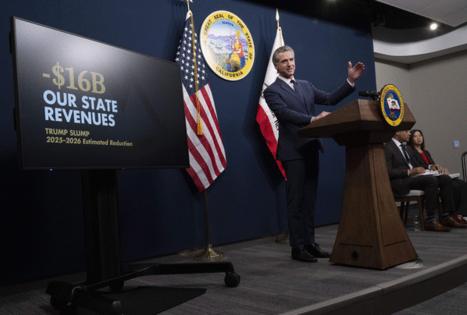What does California's dreary budget mean for state worker negotiations in 2026?
Published in News & Features
SACRAMENTO, Calif. — Every year, state employee compensation is part of California’s budget conversation. It will be no different in 2026.
California will face familiar, precarious budget conditions next year. The nonpartisan Legislative Analyst’s Office recently published the 2026-27 fiscal outlook, which revealed that Gov. Gavin Newsom and lawmakers are staring at an $18 billion deficit. That budget problem has grown by $5 billion since the Newsom administration released an estimate this summer.
Earlier this year, Newsom and the California Legislature took a number of measures to reconcile what was then a $12 billion deficit, which included using reserves and reducing payroll expenses, which the Newsom administration managed to do after calling all state worker unions back to the bargaining table. Through negotiations, the state and labor groups shaved over $700 million from the budget through pay reductions and suspensions to various retirement contributions.
Given 2026’s larger-than-expected budget problem, California leaders may look to explore additional ways to fill the deficit using state employees’ compensation as it has done in years past.
A spokesperson for the California Department of Human Resources, which leads the state’s bargaining efforts, said in a statement that the agency doesn’t comment on collective bargaining.
Based on a review of CalHR’s list of labor contracts with state employees’ bargaining units, it appears SEIU Local 1000 is the only union slated to negotiate a new contract with CalHR in 2026. The union’s leaders are gearing up for a fight.
“Though California may be facing these budget deficit problems, it’s not state workers or our salaries, or health benefits that cause these,” said Anica Walls, the president of SEIU Local 1000, the largest representative of state employees in California.
Unions say telework is part of the conversation
One area of negotiations that impacts most bargaining units is the ongoing debate over state employees’ ability to telework.
After Newsom issued a March executive order directing employees working remotely to come back to offices four days a week, unions and those they represent protested and filed legal challenges to the governor’s directive.
State employees won a year-long reprieve from the return-to-office order as part of broader negotiations this summer, which allowed some state employees to keep working from home for the majority of the week while unions agreed to pause raises and instituted a leave program that reduced workers’ pay. (Most employees didn’t see a change in their paychecks because the state agreed to pause required retirement contributions that offset the salary decrease.)
But the fight over telework remains a key position for unions heading into next year, when labor representatives will negotiate the issue with CalHR.
Telework “really is a win-win policy that benefits all Californians,” Ted Toppin, the executive director of the union Professional Engineers in California Government. “The significant budget problems point again to the benefits of telework. Telework can help address our significant state budget deficits, not just this year, but for years to come.”
Toppin pointed to the report released in August by the state auditor that estimated California could save up to $225 million in office space costs annually.
Ahead of negotiations over telework next year, Toppin had a message to the administration and the Legislature: “Take the win. It’s right before us: Reduce congestion and emissions, prevent the need to build out hundreds of thousands of square feet of office space to house employees that can do their work from home, and have done successfully for five plus years.”
‘We are always fighting for our lives’
Cal Fire Local 2881, which represents employees in the California Department of Forestry and Fire Protection, was originally slated to return to the bargaining table in 2026, when its contract was set to expire.
Knowing that raises were not on the table, based on the state’s precarious budget situation, the union opted to extend its current contract one year and push for its priorities in 2027, said Tim Edwards, the president of Cal Fire Local 2881. Edwards said this strategy will position the union well for 2027 negotiations, when the labor group plans to push for a 56-hour workweek.
Other labor groups, like the state engineers union, signed side letters that suspended the return-to-office order until July 2026, but will negotiate the issue with CalHR in the spring.
SEIU Local 1000 represents nine bargaining units that have a contract that expires in 2026, according to CalHR’s website.
Walls, the union’s president, said California’s bleak budget position was not a surprise and isn’t new to state employees. Over her nearly two decades in the civil service, Walls noted the state has taken various measures to reduce payroll costs, including furloughs and restructuring retirement benefits.
“We are always fighting for our lives, it feels like, every three years,” Walls said.
Walls said state employees already made sacrifices earlier this year when unions agreed to delay raises and OK’d leave programs that involve pay reductions. She added that SEIU Local 1000 hopes to work with the state to address the budget issue during negotiations next year, but “we’re ready to fight for what we deserve.”
Telework is one topic that SEIU Local 1000 intends to include in next year’s negotiations, Walls said.
Zero net savings from paused retirement contributions
Part of the reason California’s deficit hasn’t improved is that the state has taken several approaches to filling that budget gap that essentially kick the can down the road.
One way California did this last year was by suspending the state’s contributions to Other Post-Employment Benefits, which typically requires the employer and employees to help cover some health care costs for retirees.
As it previously predicted, the LAO reported last week that the plan to save money by suspending OPEB contributions did not result in net savings to the state. Those savings were essentially nullified by additional appropriations lawmakers passed in a budget trailer bill to fulfill California’s requirement to make debt payments under Proposition 2.
The Legislature approved a one-time $372 million payment from the General Fund to help cover the gap created by pausing OPEB contributions, explained Nick Schroeder, a fiscal analyst with the LAO who specializes in public employment. He added that this appropriation was passed in August and was therefore not reflected in the final estimates of the June budget bill.
The “net effect of suspending the employer’s General Fund OPEB prefunding contribution is zero,” Schroeder wrote in a statement.
____
©2025 The Sacramento Bee. Visit at sacbee.com. Distributed by Tribune Content Agency, LLC.







Comments